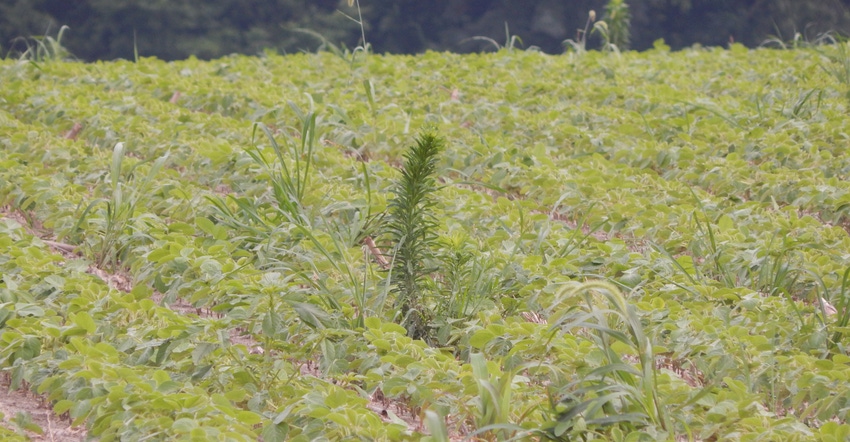March 12, 2020

The challenging 2019 growing season and delayed harvest in many areas made it difficult to complete fall fieldwork, including weed burndown. Now, crops could face even greater competition from weeds this spring.
Midwest fields received a lot of rain in September, creating an ideal environment for weeds to flourish. With fall growing conditions and milder winter weather, weeds produced seeds and have had optimal field conditions to establish dense stands of winter annual weeds this spring.
This spring, when planning their weed control, growers need to remember that herbicide and adjuvant effectiveness can change based on the temperature. Burndown and post-herbicide and adjuvant applications are most effective in temperatures between 65 and 85 degrees F. Once the temperature drops below that range, the application is at risk of being less effective. But there are ways to avoid this and make early-season applications work.
Applying herbicides in cold weather
The first step to avoiding application issues is understanding how cold weather limits herbicide capability with early-season applications. Ineffective herbicide burndown applications due to cold weather are more common when nighttime temperatures dip below 40 degrees.
“When the temperature drops, it’s more difficult for plants to metabolize nutrients from the soil. This same issue can also make it harder for weeds to absorb herbicides,” says Bruce Carlson, technical specialist for CHS Agronomy. “When the herbicide is unable to effectively reach the target, weed management isn’t as successful. Cold weather also slows weed growth and hardens cell walls. This affects uptake of the herbicide to the weed, which can lead to reduced weed control.”
To counter the negative effects of cold weather on herbicides, growers can increase the application rate and add spray adjuvants. Carlson says scouting the field about two weeks after application will reveal how well the weeds were able to absorb the herbicide. This can also help determine if a second application will be necessary. If the weeds survived the first application, plan to apply a second round about three weeks later to achieve best results.
Adjuvant use in cold weather
Preplant burndown is a common practice to minimize early-season weed pressure. “Effective postemergent herbicide applications often use adjuvants to improve efficacy and on-target application, and help the herbicide provide maximum weed control,” Carlson says. “Applicators using adjuvants with herbicide applications early in the season need to be prepared for how the lower temperatures may affect the adjuvant solutions during the application.”
Adjuvants can be very sensitive to cold temperatures and are prone to freezing when exposed to temperatures below 25 degrees. The good news is even if your adjuvants have frozen due to cold weather, the solution will be just as effective when it warms back up.
Growers have several herbicide options to use, including 2,4-D, dicamba or glyphosate, Carlson notes. By adding an adjuvant to the tank, herbicides can be more targeted and optimized for effectiveness. Since adjuvants have a higher viscosity in cold temperatures, applicators need to plan the application carefully to make sure the product is effective and to avoid herbicide injury to unintended targets.
The optimal temperature for adjuvant use is above 60 degrees, he says. “When nighttime temperatures fall to 40 degrees or below, the adjuvant can be less effective. As such, the applicator should use caution and make adjustments to maximize the benefits of the adjuvant when applying in cooler temperatures.”
Choose a high-efficiency adjuvant
Carlson says CHS Agronomy offers an adjuvant, Last Chance, a surfactant and deposition aid, which works to improve herbicide performance by maximizing uniform coverage, increasing wetting and providing strength to penetrate through waxy or weather-hardened cuticles.
“Last Chance works by spreading droplets, keeping droplets wetter longer, as well as helping penetrate leaf cuticles allowing for more overall herbicide uptake,” he explains. “By including an adjuvant with your herbicide, you are giving it the best opportunity to be successful in eliminating tougher weeds.”
This adjuvant can be used with a wide variety of herbicides and other adjuvants. “It’s designed to significantly increase performance over the standard adjuvant program,” he says, “and is compatible with a broad range of conventional and traited crops, as well as non-crop situations.”
Spring weather isn’t always cooperative and can leave growers frustrated when it leads to ineffective herbicide applications. By understanding how to optimize herbicide applications with adjuvants in cooler temperatures, Carlson says, “applicators can have an effective weed management plan to help the crop realize its maximum yield potential.”
For information on how to use adjuvants and herbicides as part of an effective weed management strategy, visit inthefurrow.com.
Source: CHS, which is solely responsible for the information provided and is wholly owned by the source. Informa Business Media and all of its subsidiaries are not responsible for any of the content contained in this information asset.
You May Also Like




